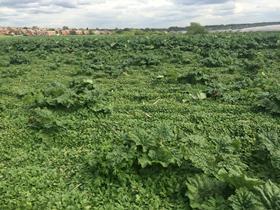
Rhubarb growers from across the UK attended a recent open day at Yorkshire producer E Oldroyd & Sons, to observe two ongoing HDC-funded herbicide trials.
Like many categories, rhubarb has recently faced an increasingly smaller list of available herbicides, so many have their hopes pinned on these trials, which are testing both new chemicals and ways of using them. “In my view it’s quite refreshing that a number of chemical companies are putting chemicals out there that aren’t named, so that we can trial them,” trial host Lindsay Oldroyd tells FPJ. “We were getting to a stage where the list of herbicides we could use was getting smaller.”
Oldroyd says the biggest challenge facing the rhubarb category is “definitely” weed control. “We have quite a unique weed in Yorkshire – Himalayan Balsam – which originates from river banks and can get into crops through irrigation systems,” he says. “It comes from the same river in Russia that rhubarb originates from, so it unfortunately likes the same things as rhubarb.”
Himalayan Balsam is currently only affecting rhubarb crops in Yorkshire, according to Oldroyd, although it is present in rivers across the UK and so producers used the day to discuss the best ways of tackling the invasive weed, if the threat spreads. “The open day had a great uptake – growers attended from as far as Southampton and Kent,” he says. “When I first joined the HDC my aim was to get more attention for rhubarb – I wanted to shout about it from the rooftops. There is definitely more attention on it now.”
This year, initial yields for forced rhubarb were “drastically down”, as a result of mild autumn weather that meant the crop did not slow down as much as usual during its latent period.
Yields for E Oldroyd’s outdoor rhubarb are currently slightly lower than average, again due to milder temperatures, which have also led to fewer thick sticks.
But Oldroyd points out that this has its benefits – it is easier to meet pack weights, and thinner sticks are more tender. “Sales at present are stagnant,” he says. “We are trying different promotions with supermarkets at the moment, such as 50 per cent extra free, and Aldi has included rhubarb as part of its Super 6.”
Business unit director at Barfoots, James Meers, says the company’s outdoor rhubarb season started production in early April and has benefited from the warm spring. “The most important factor this year is the cold winter, with 15 per cent more frost days than average over the period – this has allowed the rhubarb crowns to fully charge and production is expected to continue strongly through until early October.”
He adds: “2014 saw production halved due to the mild winter, however as the growing conditions have picked up this year, sales demand has remained flat in line with 2014. This is likely driven by the warm spring, but is also a concern for future years’ sales.”
Going forward Meers believes rhubarb needs a “sponsor” to raise its profile. “The category needs somebody who will get behind this ‘traditional’ crop and make it ‘nouvelle’,” he says. “There is a lot of production in the ground and in a year where the growing conditions have been as good as they are this year, the opportunity to bring the fantastic flavour and robustness of rhubarb to life needs to be grabbed.”
Described as a “blank palate”, rhubarb takes on the taste of anything it is mixed with, meaning marketers could target those who don’t like its natural taste but see its health benefits. “I feel that the juicing trend is one that won’t go away, so that could be a good growth area for rhubarb,” says Oldroyd. E Oldroyd & Sons primarily supplies into the retail sector, but already supplies a number of juice companies, as well as some wholesalers and foodservice firms.
The canning sector is currently dominated by continental processors, in particular Poland, says Oldroyd, but notes that the sector is benefiting from the convenience trend and so he would “never say never”.
Protecting the authenticity of rhubarb
Janet Oldroyd-Hulme, of E Oldroyd & Sons, is largely credited with gaining the Protected Designation of Origin (PDO) status for Yorkshire forced rhubarb in 2010 – the first fresh produce item to gain this recognition on the UK mainland.
“We found the uptake of the PDO label was slow initially. We tended to get people asking what it was, and being scared to be among the first to put their name in the hat,” says Oldroyd-Hulme’s son, Lindsay. “Since then it’s been about education, for both consumers and growers. We are now getting people coming forward, and within the group growers are becoming a lot more savvy.
“One thing we struggled with was the uptake of supermarkets. It’s not that they weren’t willing, but it would be down to our physical costs to put the PDO label on. We put it on our boxes and our packaging.”
In terms of a sales uplift, Oldroyd argues he would “more than recommend” growers and producers to apply for PDO status. “From speaking to wholesalers, people are physically going up to them and asking for Yorkshire rhubarb, so it is a good thing,” he says. “And there is a Michelin-starred restaurant in York with a sign saying Mr Oldroyd’s Yorkshire Rhubarb.”



